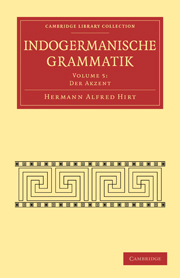Book contents
- Frontmatter
- Vorwort
- Contents
- Einleitung
- Erster Teil. Der Akzent der Einzelsprachen
- Zweiter Teil. Der Akzent des Indogermanischen
- XVI Kapitel. Die Intonation (der Silbenakzent)
- XVII Kapitel. Derindogermanische Wortakzent (Hauptton)
- XVIII Kapitel. Typus mit wechselndem Ton
- XIX Kapitel. Nomina mit festem Ton
- XX Kapitel. Betonung der Adjektiva
- XXI Kapitel. Adverbium. Zahlwort. Pronomen
- XXII Kapitel. Betonung des Verbs. Vorbemerkungen
- XXIII Kapitel. Die einzelnen Betonungstypen des Verbums
- XXIV Kapitel. Der zweite Betonungstypus
- XXV Kapitel. Der dritte Betonungstypus
- XXVI Kapitel. Der Satzakzent. Vorbemerkungen
- XXVII Kapitel. Enklise und Proklise
- XXVIII Kapitel. Betonung der Wortgruppen
- XXIX Kapitel. Die weitere Satzbetonung
- Autorenverzeichnis
- Sachregister
- Wörterverzeichnis
XXVIII - Kapitel. Betonung der Wortgruppen
Published online by Cambridge University Press: 05 August 2011
- Frontmatter
- Vorwort
- Contents
- Einleitung
- Erster Teil. Der Akzent der Einzelsprachen
- Zweiter Teil. Der Akzent des Indogermanischen
- XVI Kapitel. Die Intonation (der Silbenakzent)
- XVII Kapitel. Derindogermanische Wortakzent (Hauptton)
- XVIII Kapitel. Typus mit wechselndem Ton
- XIX Kapitel. Nomina mit festem Ton
- XX Kapitel. Betonung der Adjektiva
- XXI Kapitel. Adverbium. Zahlwort. Pronomen
- XXII Kapitel. Betonung des Verbs. Vorbemerkungen
- XXIII Kapitel. Die einzelnen Betonungstypen des Verbums
- XXIV Kapitel. Der zweite Betonungstypus
- XXV Kapitel. Der dritte Betonungstypus
- XXVI Kapitel. Der Satzakzent. Vorbemerkungen
- XXVII Kapitel. Enklise und Proklise
- XXVIII Kapitel. Betonung der Wortgruppen
- XXIX Kapitel. Die weitere Satzbetonung
- Autorenverzeichnis
- Sachregister
- Wörterverzeichnis
Summary
Allgemeines. Um außer der Enklise die abstufende Betonung der Wortgruppen zu ermitteln, sind wir in mehr als einer Hinsicht auf die Zss. und von den Sprachen in hohem Maße auf das Indische angewiesen, zu dem wir aber, auch wenn es allein zeugt, volles Vertrauen haben können, da sich ja seine Betonung in fast allen Punkten als ursprünglich erwiesen hat. Wo die verwandten Sprachen zeugen, bestätigen sie im allgemeinen die Tatsachen des Indischen.
Über die Betonung der indischen Komposita haben gehandelt: R. Garbe, Das Accentuationssystem des altind. Nominalkompositums, KZ. 23, 470 ff.; J. N. Reuter, Die altindischen Nominalkomposita, ihrer Betonung nach untersucht, KZ. 31, 157 ff., 485 ff.; F. Knauer, Über die Betonung der Komposita mit a priv. im Sanskrit, KZ. 27, 1 ff. Zusammenfassend Wackernagel, Aind. Gramm. 2, 1, § 17, 90—94, 96, 103—106, 113—115. Vergleichend L. Schroeder, Die Akzentgesetze der homer. Nominalkomposita, mit denen des Veda verglichen, KZ. 24, 101 ff.
Die Doppelung. Wir beginnen mit der Doppelung, mit der Wiederholung der gleichen Worte. Man kann hier zwei Fälle unterscheiden. Eines Teils stehen die Worte einfach nebeneinander oder sie sind zusammengewachsen, und dann ist die Doppelung z. T. verstümmelt. Vgl. IGr. 4, 1 ff. Aber man wird trotzdem die Betonung beachten müssen.
1. Interjektionen scheinen auf dem zweiten Glied betont gewesen zu sein:
gr. ἀτταταῖ, ὠαιαί, ὀτοτοῑ, βαβαιάξ, ἐλελεῦ; αἰαῖ; ἓ ἔ; ἣ ἤ; οἰοῑ; βρεκεκεκέξ; ἀλαλά.
- Type
- Chapter
- Information
- Indogermanische Grammatik , pp. 370 - 397Publisher: Cambridge University PressPrint publication year: 2009First published in: 1929



